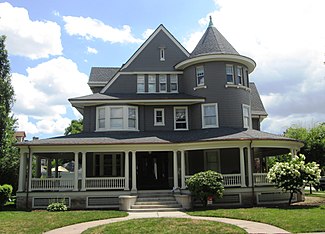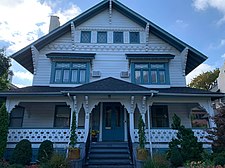
Prospect Park is an urban park in Brooklyn, New York City. The park is situated between the neighborhoods of Park Slope, Prospect Heights, Prospect Lefferts Gardens, Flatbush, and Windsor Terrace, and is adjacent to the Brooklyn Museum, Grand Army Plaza, and the Brooklyn Botanic Garden. With an area of 526 acres (213 ha), Prospect Park is the second largest public park in Brooklyn, behind Marine Park.
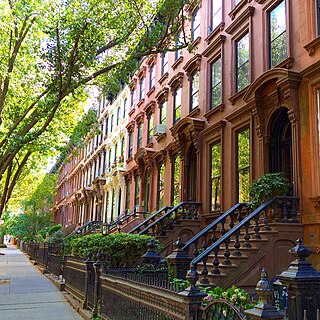
Park Slope is a neighborhood in northwestern Brooklyn, New York City, within the area once known as South Brooklyn. Park Slope is roughly bounded by Prospect Park and Prospect Park West to the east, Fourth Avenue to the west, Flatbush Avenue to the north, and Prospect Expressway to the south. Generally, the section from Flatbush Avenue to Garfield Place is considered the "North Slope", the section from 1st to 9th Street is considered the "Center Slope", and south from 9th Street, the "South Slope". The neighborhood takes its name from its location on the western slope of neighboring Prospect Park. Fifth Avenue and Seventh Avenue are its primary commercial streets, while its east–west side streets are lined with brownstones and apartment buildings.
Fiske Terrace is a planned community and neighborhood in the New York City borough of Brooklyn. Fiske Terrace is located in south central Brooklyn in the southern edge of the community of Flatbush and north of the community of Midwood. It is bounded by Glenwood Road on the north, Ocean Avenue on the east, the Bay Ridge Branch of the Long Island Rail Road/New York and Atlantic Railway right-of-way on the south, and the New York City Subway BMT Brighton Line subway line on the west.
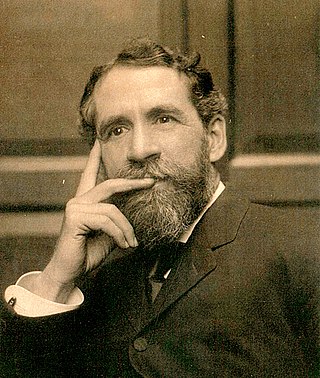
William Bunker Tubby was an American architect who was particularly notable for his work in New York City.

Ditmas Park is a historic district in the neighborhood of Flatbush in Brooklyn, New York City. The traditional boundaries of Ditmas Park, including Ditmas Park West, are Ocean Avenue and greater Flatbush to the east, Dorchester Road and the Prospect Park South neighborhood to the north, Coney Island Avenue and the Kensington neighborhood to the west, and Newkirk Avenue to the south. The name Ditmas Park is often used a shorthand for the several neighborhoods that comprise the larger area of Victorian Flatbush.

Buildings, sites, districts, and objects in Virginia listed on the National Register of Historic Places:

Prospect Lefferts Gardens is a residential neighborhood in the Flatbush area of the New York City borough of Brooklyn. The community is bounded by Empire Boulevard to the north, Clarkson Avenue to the south, New York Avenue to the east, and Ocean Avenue/Prospect Park to the west. Prospect Lefferts Gardens was designated a New York City Landmark area in 1979 and called the Prospect Lefferts Gardens Historic District.

Beverley Square East and Beverley Square West, also spelled Beverly Square, are a pair of neighborhoods in the Flatbush section of the New York City borough of Brooklyn. Located southwest of Prospect Park within what is now called Victorian Flatbush, one of the largest concentrations of Victorian houses in the United States, they were developed in the 1900s primarily by Thomas Benton Ackerson, whose former home is in Beverley Square West.

The Lefferts Historic House is located within Prospect Park in Brooklyn, New York City. Built circa 1783, it is the former home of enslaved persons and the family of Continental Army Lieutenant Pieter Lefferts. It currently operates as a museum of the Leffertses' family life in Kings County. The museum is part of the Historic House Trust, owned by the New York City Department of Parks and Recreation and operated by the Prospect Park Alliance. It is a New York City designated landmark.
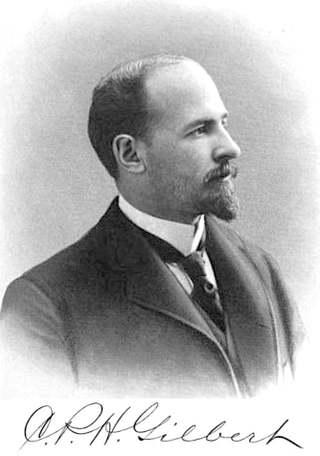
Charles Pierrepont Henry Gilbert was an American architect of the late-19th and early-20th centuries best known for designing townhouses and mansions.

The Flatbush Reformed Protestant Dutch Church, also known as the Flatbush Reformed Church, is a historic Dutch Reformed church – now a member of the Reformed Church in America – at 890 Flatbush Avenue in the Flatbush neighborhood of Brooklyn, New York City. The church complex consists of the church, cemetery, parsonage and church house.

The buildings at 375–379 Flatbush Avenue and 185–187 Sterling Place are a historic group of four commercial and residential buildings located in the Prospect Heights neighborhood of Brooklyn, New York City. They were built in 1885 and are in the Neo-Grec style with Second Empire elements. The 377–379 Flatbush Avenue building is a 3.5-story masonry structure with a commercial ground floor, apartments above, and a distinctive corner tower with pyramidal roof. It features a mansard roof. The 375 Flatbush Avenue building is a commercial/residential structure identical in form to 377–379 Flatbush Avenue, but without a mansard roof. The 185–187 Sterling Place buildings are two single family row houses built as companions to the other buildings.

The Albemarle–Kenmore Terraces Historic District is a small historic district located in the Flatbush neighborhood of Brooklyn, New York City. It consists of two short cul-de-sacs, Albemarle Terrace and Kenmore Terrace, off of East 21st Street, and the 32 houses on the two streets, as well as a four-family apartment building at the end of Albemarle Terrace. The New York City Landmarks Preservation Commission, which designated the district as a landmark in 1978, noted that the "terraces are distinguished by the uniform use of materials, height and color producing a harmonious effect".
This is a timeline and chronology of the history of Brooklyn, New York. Brooklyn is the most populous of New York City's boroughs, and was settled in 1646.

Victorian Flatbush is the western section of the Flatbush section of Brooklyn, New York, bordering Midwood, that is characterized by Victorian houses.

John Yapp Culyer was an American civil engineer, landscape architect, and architect, who worked on parks in Chicago, Pittsburgh and other cities. He is known as the Chief Landscape Engineer of Prospect Park opened in 1867.

Kirby, Petit & Green was an American architectural firm practicing in New York City, noted as the architects of Coney Island's Dreamland, among other major commissions. The three principals were architects Henry P. Kirby, John J. Petit, and James C. Green.

The Flatbush Malls are a series of tree-lined landscaped medians along several roads in the Victorian Flatbush neighborhood of Brooklyn, New York City. An architecture critic has written that the malls "give the streets an uncommon spaciousness, if not grandeur". The first series was built in the northern part of the neighborhood along Albemarle Road, and extending one block north on Buckingham Road, in the Prospect Park South development of 1899, east of Coney Island Avenue and west of the BMT Brighton Line. This was modeled by the Scottish landscape architect John Aiken on Commonwealth Avenue Mall in Boston, with a design that originally included shrubbery but not trees, and in turn likely inspired the other neighborhood series. The second series, also known as the Midwood Malls, was built in the southern part of the neighborhood along both Glenwood Road, east of Coney Island Avenue and west of Delamere Place, as well as the intersecting East 17th Street, north of the Long Island Railroad cut of the Bay Ridge Branch and south of Foster Avenue, in the Fiske Terrace-Midwood Park developments of 1905.

The Willink Entrance area, also known as Willink Plaza, is a major urban square of Brooklyn, New York City, formed by the intersection of Flatbush Avenue, Ocean Avenue and Empire Boulevard, at the eastern corner of Prospect Park and the southern corner of the Brooklyn Botanic Garden. It is serviced by the New York City Subway's Prospect Park station, and features several public spaces and historic buildings. This location is considered the northwestern point of the Prospect Lefferts Gardens neighborhood of Flatbush, and adjoins Crown Heights to its northeast.
Dean Alvord was an American real estate developer, college professor, and philanthropist known for his real estate developments in the New York City Metropolitan Area and in Florida. He was a relative of both Johnathan Edwards and Aaron Burr.
